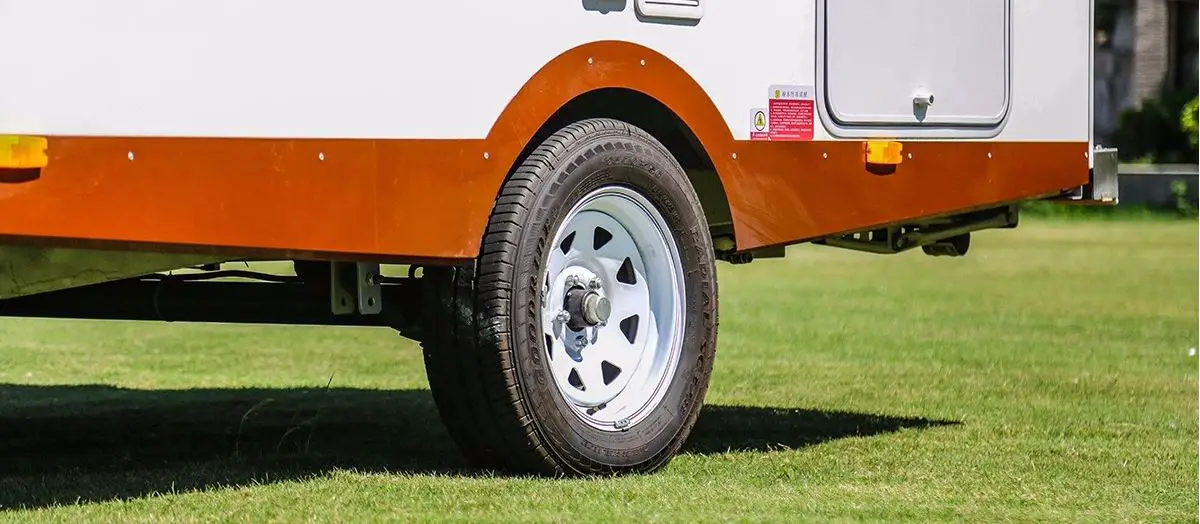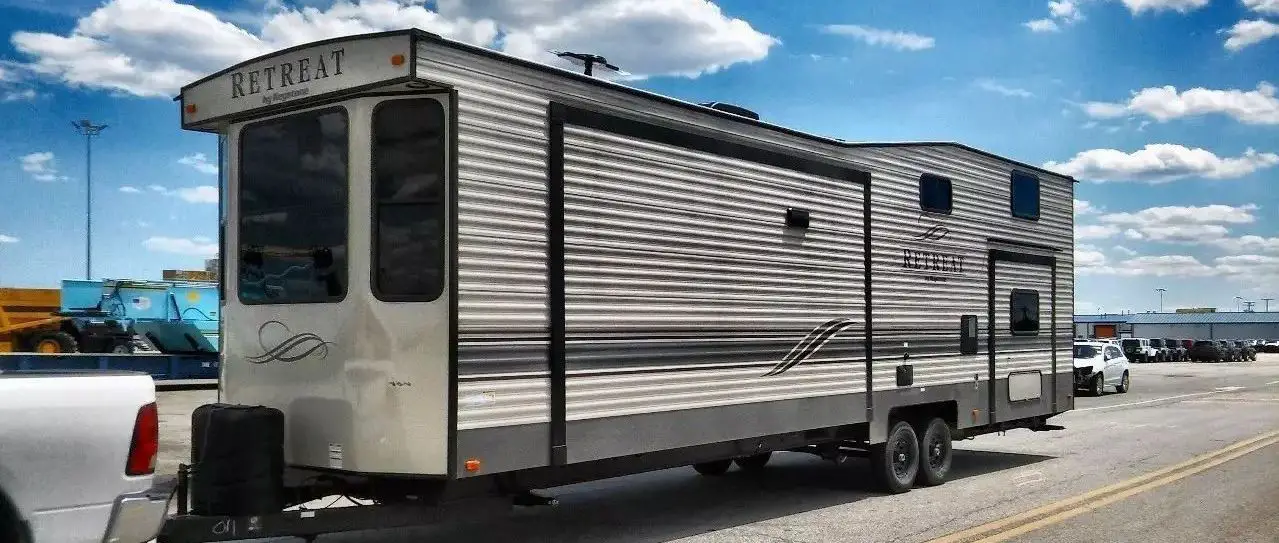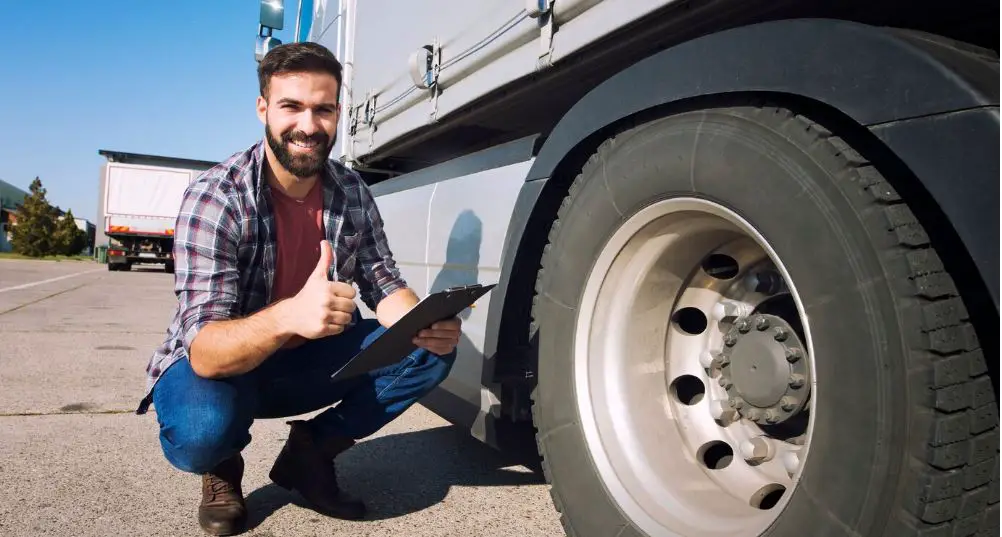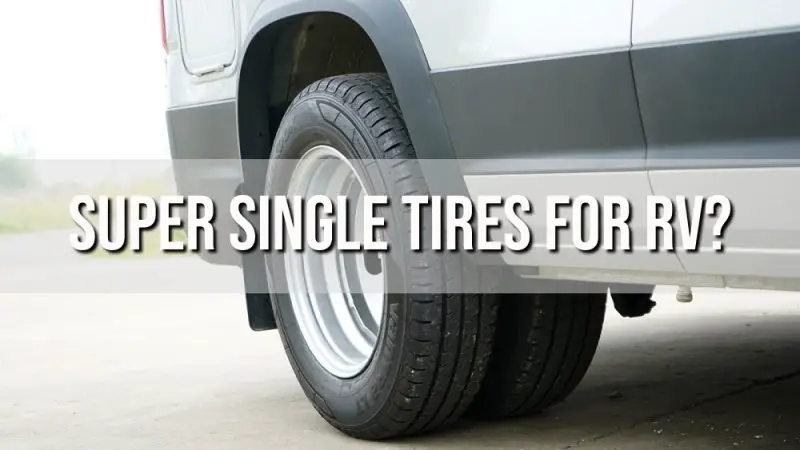Super single tires, sometimes called wide base or wide profile tires, are an alternative to the standard dual rear wheel configuration found on many large recreational vehicles. Super singles use one wider, lower-profile tire in place of two standard tires on each side of the axle. RV owners may wonder if switching to these massive single tires offers benefits over traditional duals. This article examines the pros and cons of super single tires for RVs to help determine if one big tire truly performs better than two.
Key Takeaways
- Super singles provide payload increase and better handling, but need reinforced wheels.
- The wider tread disperses weight over more surface area for traction and wear.
- Overall tire cost is lower, but individual replacement tire price is higher.
- Special wheels and parts limit roadside serviceability for super singles.
- Evaluate RV usage, loads, and infrastructure access to decide on best tire type.

How Super Single Tires for RVs Work
Super single tire technology was originally developed for commercial trucks to address issues with traditional dual rear wheels. The wider, lower-profile single tire takes the place of duals on each side of the rear axle. Some key differences include:
- Size: Super singles are wider, with section widths up to 16 inches or more. This provides a larger contact patch than two narrower tires stacked together.
- Aspect ratio: The tire’s sidewall profile is significantly shorter on super singles. Whereas standard RV tires have an aspect ratio of 75-85, super singles fall around 65-75.
- Weight rating: The extra width enables super single tires to support higher inflation pressures and loads per tire. Load ratings can exceed 5,000 lbs for RV applications.
- Wheels: Super singles require special reinforced single wheels to handle the higher weight and pressure demands.
By concentrating the entire axle load into one tire, super singles offer potential performance benefits compared to duals while using less material. However, there are also drawbacks to running one massive tire.
Potential Benefits of Super Single Tires on RVs
The unique wider, lower-profile design of super single tires provides RV owners specific advantages compared to traditional dual rear wheel sets.
Increased payload capacity: By consolidating the total axle load into one tire, super singles can support over 5,000 lbs each, versus 3,000-3,500 lbs for standard tires. This extra 1,500+ lbs of capacity enables carrying more fresh water, gear, toys, or cargo.
Improved handling: The extra-wide tread width of 14” or more gives super singles a broader, flatter footprint than duals. This distributes the RV’s weight over more surface area for better traction and lateral grip when cornering or braking. Handling feels more stable and precise.
Decreased rolling resistance: With only one bulky tire rotating instead of two per corner, super singles experience less internal friction and drag. Reduced rolling resistance equals a mild 1-3% boost in fuel economy.
Reduced hydroplaning: Super single tires channel water away more efficiently due to the extra-wide tread and stiffer sidewall. Dual tires can trap water between them. The superior water evacuation provides better wet weather handling.
Lower overall tire weight: Counterintuitively, a single massive tire weighs less than two smaller ones stacked together. The single wheel is heavier but the total tire mass savings lightens the load.
Less wasted material: Dual tires have unused rubber squeezed between them that wears slowly. Super singles eliminate this inefficient wasted tread, using less total rubber.
Lower lifetime costs: The higher upfront price of supers singles is offset over time by their extremely long service life of 500,000+ miles, 2-3X standard tires.
Potential Drawbacks of Super Singles
While super single tires excel in many performance aspects, there are some inherent disadvantages to using one very large tire instead of duals.
- Higher individual tire cost: The larger size and reinforced construction means a single super single tire costs $600-$1000, whereas standard ST tires are only $250-$500 each.
- Special wheels required: Super singles necessitate heavy one-piece wheels rated for the higher pressures and loads, adding cost and complexity.
- No redundancy: With duals, a spare tire provides backup should one fail. Super singles have no fail-safe if the tire is punctured or damaged.
- Difficult roadside repair: Service trucks carry few parts suited for repairing these non-standard mammoth tires. Tire chain service is extremely limited.
- Incompatible with spare: The reinforced super single wheel won’t match a standard sized spare tire. No backup if a super single is damaged.
- Limited availability: Super single tires, wheels, and certified service are still relatively rare, compared with ubiquitous standard ST tires.
While super singles can save long-term, the initial investment in new wheels and tires is high. Drivers risk lengthy delays if a super single has issues far from specialized service.

Super Single vs Dual Rear Tires for RVs
| Comparison | Super Single Tire | Dual Tire Set |
|---|---|---|
| Tire Section Width | 14-18 inches | 8-12 inches |
| Aspect Ratio | 65-75 | 75-85 |
| Load Capacity Per Tire (lbs) | 5000+ | 2500-3500 |
| Wheel Type | Special reinforced single | Standard dual wheels |
| Cost Per Tire | $600-$1000 | $250-$500 |
| Overall Weight | Lower | Higher |
| Redundancy | None | Has spare if tire fails |
| Handling | Better due to wider footprint | Sufficient but not as stable |
| Repairability | Difficult, needs special equipment | Simple, standard wheels |
When directly comparing super single and dual rear tires, there are clear trade-offs depending on RV usage. Singles perform better and reduce weight, but come at a higher upfront investment and repair challenges. For the right application, the pros may outweigh the cons.
Suitability of Super Singles for Different RVs
Super single rear tires offer benefits for certain types of recreational vehicles but may not be ideal for others.
Motorhomes
The extra payload, stability, and lower rolling resistance of super singles make them a great choice for improving large motorhome handling and carrying capacity. Their size is not an issue since serviceability is less critical.
Fifth Wheels & Travel Trailers
Fifth wheels with slide-outs can benefit from the wider stance and payload gain, which allows more cargo. The difficulty of repairing supers singles makes them less feasible for travel trailers.
Class B & C Motorhomes
The smaller size and better maneuverability of Class B and C RVs are not improved enough by super singles to justify the higher costs and service challenges.
Toy Haulers
For toy haulers, super singles enable bigger loads in the garage while maintaining stability. This maximizes hauling capacity for off-road equipment and trailers.
Factors to Consider Before Switching to Super Singles
Determining if upgrading to super single rear tires is the right move depends on closely evaluating several key factors:
Type of RV: The extra stability and load capacity of super singles provide the most benefit for heavy, cumbersome vehicles like large Class A motorhomes or fifth wheel toy haulers where duals struggle. For maneuverable Class B/C RVs, the advantages are less substantial.
Typical loads: If you frequently haul maximum weight, carry water tanks full, pull big trailers, or have cargo in the basement, the extra 1,500 lb+ payload per tire with super singles allows maximizing that capacity. Their advantage diminishes if you RV lightly loaded.
Tire lifespan: For RV owners logging 100,000+ miles annually, the 2-3X longer lifespan of super singles offsets their higher initial cost over time. More casual RVers may not reach the mileage where super single durability pays off.
Driving terrain: Super singles perform better on loose, uneven surfaces like gravel or dirt roads. RVers who often boondock or drive off-pavement should consider the improved traction super singles offer in those conditions versus duals.
Access to service: With few technicians trained to work on them, super singles pose an inconvenience if damaged in a remote area. Duals can be quickly remedied or swapped most anywhere. This makes super singles less ideal for desolate travel.
Budget: The higher upfront investment for new wheels and tires is more approachable for luxury RV owners. Cost-conscious buyers may be deterred by the high price per replacement tire, despite long-term savings potential.
Carefully evaluating your RV, travel style, and finances helps determine if super single benefits like stability and durability or drawbacks like service limitations are more impactful. Their pros and cons are vehicle and use-case specific.

Installation Process for Super Single Tires
While any qualified tire shop can handle mounting and balancing standard dual rear tires, upgrading an RV from duals to super singles involves installing specialty parts and precisely recalibrating the axle components.
The process starts with exchanging the existing inner and outer wheel hubs for new large, reinforced super single hubs engineered specifically to handle the higher weight loads and inflation pressures generated by the massive single tires. Technicians will dismount the dual tires and wheels and remove all the standard inner axle hardware to make room for the new super single hub.
Next, the new heavy-duty single wheel gets test fitted and bolt-mounted at the outer wheel position in place of where the previous outer dual wheel was located. With the integrated hub and single wheel now installed, the mammoth super single tire can be mounted and inflated to precise specifications.
Attention then shifts to adjusting the suspension. The ride height, balance, alignment settings, and weight ratings all need fine-tuned to account for the larger diameter wheel and tire combo. Electronic and mechanical settings are optimized to ensure proper handling, tire wear, and chassis load limitations.
Finally, the RV undergoes a thorough multi-point alignment check. The camber, toe, and caster are verified to be within OEM specifications to maximize tire life and ensure straight tracking down the road. Test drives monitor for any pulling or irregular wear.
This customized multi-step installation and calibration process requires specialized parts, tools, and training. Attempting to retrofit super singles yourself is not advisable. Consult certified experts.
Maintaining Super Single Tires
While super single tires are engineered for enhanced durability and longevity compared to standard dual tires, they still require diligent maintenance and care over their lifespan to reach the potential 500,000+ mile service life.
Monitoring inflation pressure is critical. Use an accurate heavy-duty truck-grade pressure gauge to check PSI, as car-type gauges are often imprecise on these mammoth tires. Inflate super singles to 5-10 PSI above the maximum imprinted sidewall pressure for optimal load carrying capacity, fuel economy, and tread life. Underinflation causes rapid wear.
Inspect tread depth at every oil change or tire rotation. Super singles may go hundreds of thousands of miles, but replace them once the tread depth wears down to 5/32 of an inch or less. Rotate supers singles every 5,000-8,000 miles to equalize wear patterns. Mount the newest tires on the front for better handling.
Frequently check super single wheels closely for any cracks, damage, or air leaks, which lead to failure. The special reinforced wheels must withstand incredible loads. Repair or replace damaged wheels immediately. Improper wheel fitment voids the tire warranty.
Out-of-balance super single tires cause uneven wear, vibration issues, and strain on steering and suspension. Re-balance supers singles annually or after any repairs. Balance is crucial due to their heavyweight and high speeds.
Misalignment accelerates tread irregularities and compromised handling. If the RV seems to pull or tires show scalloped patterns, have it realigned. Maintaining proper camber, caster, toe, and ride height ensures maximum performance and tire life from super singles.
Proactively caring for super single tires ensures they achieve their intended longevity and keep your RV safely on the road. Check pressures often, inspect for damage frequently, and seek professional service for repairs or alignments.
Conclusion
For certain large RVs like motorhomes and big fifth wheels where the benefits outweigh limitations, upgrading to super single rear tires can boost carrying capacity, stability, and cost efficiency compared to dual wheel sets. But their specialized service and repair requirements may make super singles less feasible for other types of recreational vehicles and travel needs. Consider usage, budget, and access to repair facilities when deciding if one wider tire offers advantages over two. Whichever configuration you choose, be diligent about maintenance, limit loads to tire ratings, and drive responsibly.
Frequently Asked Questions
How much weight can super single RV tires hold?
Super single tires designed for RVs commonly have weight capacities over 5,000 lbs per tire. Sets can handle 14,000-17,000 lbs total vehicle weight when properly inflated.
Do super singles improve RV handling?
Yes, the wider tire tread provides a larger contact patch on the road that disperses weight more evenly than narrower dual tires. This enhances handling, braking, and control.
Are super singles better for fuel economy?
The lower rolling resistance and reduced overall weight of super singles versus duals provides a minor fuel efficiency improvement, typically 1-3%.
Can you put a super single on the front of an RV?
No, super single tires are not designed to handle the extra scrubbing and wear from being a steer tire. They are only used on rear drive axles.
What PSI should super single RV tires be inflated to?
Inflate super single RV tires 5-10 PSI higher than the max imprinted sidewall pressure for ideal load carrying capacity and wear life. So for an 80 PSI tire, run 85-90 PSI.
How long do super single RV tires last?
With proper maintenance and operation, super single tires will last up to 500,000 miles or more. They run about 2-3 times longer than standard RV tires before needing replacement.
Can you repair a punctured super single RV tire?
Yes, but it requires special plugging and patching tools sized for the wider tire. Most truck stops are unable to repair supers singles, so carry a tire repair kit.
Are super singles more expensive than dual RV tires?
The initial purchase price per tire is 2-3 times higher for a super single. However the extended lifespan means lower lifetime tire costs overall.
Do you need a special wheel for super single RV tires?
Yes, super singles require expensive reinforced single wheels rated to handle the higher pressures and loads. Standard dual wheels cannot be used with super singles.
Where can you buy super single RV tires?
Major tire retailers like Discount Tire may carry super single tires for RVs. Truck stops like TA or Love’s might also stock them. Inventory is limited so call ahead.






